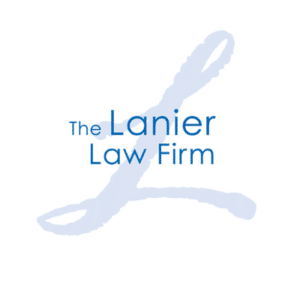Asbestos in Flooring
Asbestos was used in flooring until as recently as 1997. Nearly every component of flooring contained asbestos, including tiles, sheet flooring, adhesives, and underlayment. Asbestos flooring threatens human health when it becomes damaged or worn.
Home » National Mesothelioma Law Firm » Asbestos Exposure » Asbestos in Consumer Products and Materials » Asbestos in Flooring
What flooring materials were made with asbestos?
When did companies stop using asbestos in floor tiles?
How can I tell if flooring contains asbestos?
How are people exposed to asbestos in flooring?
Where can asbestos flooring be found?
What should I do if I have asbestos floor tiles in my home?
Occupations Exposed to Asbestos in Flooring
Health Effects of Asbestos in Flooring
Companies That Manufactured, Imported, or Processed Asbestos Flooring Materials
Asbestos is a carcinogenic substance that was used in building components during most of the 1900s. It was valued in flooring because of its tensile strength, flexibility, and durability. Asbestos flooring could expand and contract with fluctuating temperatures and resist heat, moisture, and rot.
As long as asbestos remains encased in the flooring, it is not generally released into the environment. However, floors are subject to foot traffic, the movement of furniture, accidents, abuse, and wear. Asbestos is consequently released into the environment and inhaled or ingested, leading to mesothelioma and other devastating illnesses later in life.
What flooring materials were made with asbestos?
Asbestos was used in the visible layers of flooring, such as the tiles, but it was also hidden beneath the tiles in the underlayment and adhesives.
Asbestos Floor Tiles
The Occupational Safety and Health Administration requires workers to presume all vinyl and asphalt floor tiles installed before 1980 contain asbestos. This presumption requires workers to handle the tile in accordance with government standards for safety, including sealing off the area and wearing the appropriate protective equipment.
Vinyl Asbestos Tiles
Vinyl asbestos tiles were sold in multiple forms. According to the Environmental Health and Safety Database, thermoplastic vinyl-asbestos tiles were commonly used for large-scale applications such as schools and public buildings. They were also used in homes and offices.
Vin-Tec labs, an asbestos testing company, has observed that thermoplastic tiles had an asbestos concentration significantly high compared to other floor tiles. They typically contained chrysotile asbestos, but amphibole types have also been found. Thermoplastic tiles are brittle, and it is not uncommon to encounter chipped and broken thermoplastic asbestos tiles.
Regular vinyl asbestos tiles are softer than the thermoplastic types, and they can be easily confused with vinyl composition tiles that do not contain asbestos.
Both asbestos and non-asbestos vinyl tiles may have been used to replace damaged thermoplastic tiles, which could result in a mixture of different types of vinyl tiles in one setting. As a result, it is important to test multiple tiles when checking for asbestos.
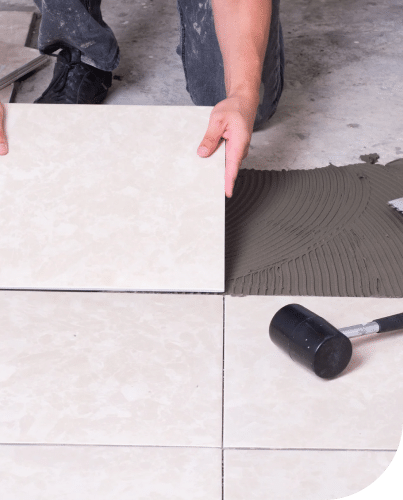
Asphalt Asbestos Tiles
Asphalt asbestos tiles were a by-product of asbestos mining, and they originally came about as a result of experiments performed in the roofing industry. These tiles contained asphalt, gilsonite, and asbestos. The asbestos content was as high as 70 percent in some brands, according to Waxie Sanitary Supply. Asphalt asbestos tiles were popular between the 1920s and the 1960s.
Asbestos Flooring Backing and Underlayment
Regardless of the presence of asbestos in primary flooring materials, asbestos commonly lurks in the unseen layers of flooring. One of these layers is the backing or underlayment. These materials were typically known as flooring felts or reinforcing paper. Flooring felt provides a moisture barrier between the flooring and the subfloor and provides soundproofing benefits.
Asbestos flooring felt resembled tar paper and was essentially the same product used in roofing felt, with an asbestos content as high as 87 percent. Although its use was not banned on roofs, flooring felt was one of the few items that remained banned after the court overturned the EPA’s 1989 ban on most asbestos products.
Asbestos in Flooring Adhesives
Floor tiles were commonly secured using black mastic, which contained an asphalt binder with asbestos added for resilience and flexibility. According to Indoor Science, a ServiceMaster Company, black mastic in older flooring typically contained one to five percent asbestos. Eventually, yellow and clear adhesives replaced black mastic, which, in rare cases, also contained asbestos.
Asbestos Sheet Flooring
Asbestos vinyl sheet flooring was also known as resilient sheet flooring. Vinyl sheet flooring did not always contain asbestos, but it was commonly installed with asbestos backing.
Vinyl sheet flooring was a separate product from linoleum. The original linoleum was a linseed-based product with a jute backing that did not contain asbestos, according to Inspectapedia. However, all sheet flooring is commonly referred to as linoleum.
When did companies stop using asbestos in floor tiles?
The Environmental Protection Agency began regulating the use of asbestos in building products in 1973 after the public became aware of its hazards to human health. However, passing asbestos regulations proved to be an uphill battle against the asbestos companies who would lose profits if it were banned.
In 1989, the U.S. Government banned certain asbestos building products, including flooring felt. However, these companies were allowed to continue manufacturing, processing, and importing these products until August 27, 1990. They were allowed to continue selling out their inventories until August 25, 1992.
While most manufacturers stopped selling asbestos flooring before 1980 due to public concerns, it was not banned. This raises the possibility that homes built later than 1990 may have asbestos flooring.
Asbestos floor tile itself was not banned until April 2019, when the EPA issued a final rule under the Toxic Substance Control Act that prohibits discontinued asbestos products from re-entering the marketplace. The regulation specifically includes asbestos floor tiles.
How can I tell if flooring contains asbestos?
The only safe way to confirm or rule out the presence of asbestos in flooring is to have it tested. This cannot be done through visual inspection alone. However, several characteristics make flooring especially suspicious for containing asbestos.
Tile Size
According to Inspectapedia, asphalt and vinyl asbestos floor tiles were produced in the following square sizes:
- Nine-inch
- 12-inch
- 18-inch
The nine-inch square tiles are the most infamous for their likelihood of containing asbestos. The 18-inch size was the least common. According to Waxie Sanitary Supply, the nine-inch size was more common before 1960, and the 12-inch became more prominent after 1960.
Asbestos tiles were also sold in smaller sizes and as decorative strips. Their thickness was generally 1/16, 3/32, or 1/8 of an inch. According to Asbestos123, asbestos tiles were noticeably thicker than other tiles.
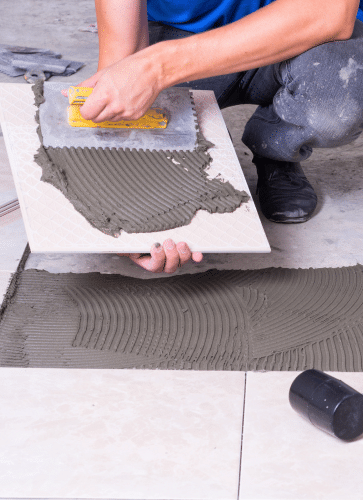
Tile Color and Pattern
Asphalt asbestos tiles were generally darker in color because of the black pitch in the asphalt. Vinyl asbestos tiles could be lighter colors. Asbestos floor tiles were sold in a variety of patterns and designs, and the design pattern alone is insufficient to definitively determine whether your flooring contains asbestos.
If you notice any discoloration on your tiles, this could be an indication that the tiles are asphalt tiles that likely contain asbestos. The discoloration is a result of oil leakage from within the asphalt.
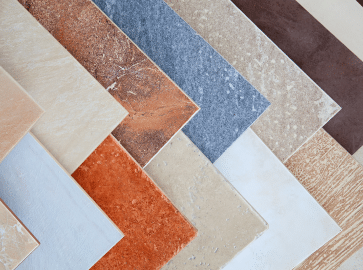
The Age of the Floor
If the building was constructed before the early 1990s, it is reasonable to suspect that any vinyl flooring may contain asbestos. If your home or work building is older, it is important to consider the underlayment and adhesive also, even if the tile itself does not contain asbestos.
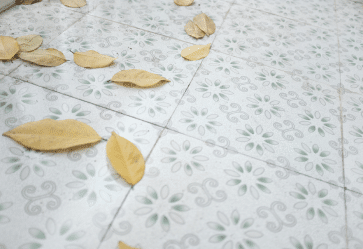
How are people exposed to asbestos in flooring?
Flooring is one of the most hazardous areas for asbestos because floors are actively used. They are easily scratched or damaged in the course of everyday life. They can also wear over time as a result of foot traffic. The improper use of harsh chemicals and floor scrubbers also threatens to harm floors.
When floors experience damage as a result of any of these causes, the asbestos can be exposed and released into the environment. It can then be inhaled and ingested, resulting in an increased risk of asbestos-related illnesses decades later.
Workers that provide flooring installation, maintenance, and removal experience significant asbestos exposure as a result of the following:
- Exposing the flooring felt or backing
- Cutting the tiles or the felt
- Removing broken tiles
- Sanding or scrubbing flooring surfaces
- Scraping mastic or other adhesives
Any workers who are bystanders during these activities can also experience significant exposure.
Where can asbestos flooring be found?
Asbestos flooring was widely used in residential and commercial applications because it was inexpensive, lightweight, durable, and aesthetically pleasing. As a result, it was used in homes, schools, commercial buildings, and public buildings. Asbestos flooring is still in place in many of these locations.
This is especially concerning in schools, where heavy foot traffic can increase the level of wear, and floors are more likely to experience damage.
What should I do if I have asbestos floor tiles in my home?
If the flooring in your home is in good repair and air testing is negative for asbestos, your safest and often least expensive option is to leave the floor in place and cover it with a new floor. If you intend to renovate, or if the floor is in poor condition, an asbestos abatement company may recommend removing the floor.
Removing the floor is generally not the preferred abatement method because doing so risks disturbing a large number of asbestos fibers. One of the most hazardous substances to remove in flooring is mastic, which may be gummy and require significant scraping to remove.
After all materials are removed, they must be disposed of in a hazardous waste facility designated for asbestos. Each step is extremely hazardous and should only be attempted by a licensed asbestos abatement contractor.
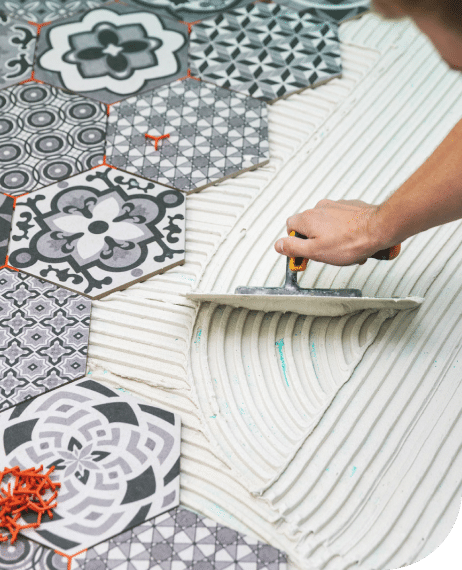
Occupations Exposed to Asbestos in Flooring
Asbestos in flooring can lead to passive and active occupational asbestos exposure. School teachers, office workers, administrative workers, and military personnel have experienced significant asbestos exposure as a result of being in an environment where asbestos was present, even though they were not directly handling it.
Workers in occupations that require them to handle flooring have the highest risk of developing mesothelioma. These workers include various construction trades and workers that perform services that require them to cut into flooring for any reason. For example, a plumber may have to cut into the flooring to access pipes.
Although asbestos flooring is no longer installed today, workers can still face significant exposure from existing flooring. Workers that may be exposed to asbestos in flooring include the following:
- Flooring installers
- Plumbers
- Electricians
- Furnace workers
- Maintenance workers
- Demolition workers
- Remodelers
- Carpenters
- Shipyard workers
Health Effects of Asbestos in Flooring
Being exposed to asbestos in flooring on a daily basis increases your risk of developing deadly mesothelioma, lung cancer, and asbestosis. The risk is particularly high for workers with a history of handling asbestos materials on a daily basis over an extended period. These diseases are associated with debilitating breathing difficulties and a poor prognosis.
Companies That Manufactured, Imported, or Processed Asbestos Flooring Materials
The companies below have manufactured, imported, or supplied asbestos products used in flooring:
- Armstrong World Industries
- Congoleum Corporation
- Nicolet, Inc.
- Tarkett, Inc.
- Biscayne Decorative Products Division of National Gypsum Company
- Amtico Flooring
- Eternit Corporation
- Everwear Flooring
- Flintkote Corporation
- GAF Ruberoid Corporation
- Goodyear Tire & Rubber Company
- Kentile Floors
- Matico Flooring
- Manning Mills Flooring
- Montgomery Ward
- Owens Corning Corporation
- Pebco Floron Flooring
- Philip Carey Asbestos Products
- Sears & Roebuck

Compensation for Asbestos Exposure in Flooring
If you have developed an asbestos-related health condition as a result of asbestos exposure, you may be entitled to recover substantial compensation through a mesothelioma lawsuit against the companies that manufactured asbestos-containing flooring products.
The following flooring companies have reorganized under Chapter 11 bankruptcy and established asbestos trust funds as required by § 524(g):
- Armstrong World Industries
- Congoleum Corporation
- Flintkote Corporation
- National Gypsum Company
- Owens Corning Corporation
- Kentile Floors
If any of these companies are responsible for your asbestos exposure, you may be eligible to file a trust fund claim. This may allow you to receive compensation sooner. Our clients are often eligible to file multiple mesothelioma claims.
Asbestos flooring was extensively used on military ships. You cannot sue the military, but if you worked aboard a ship or submarine while serving on active duty in the U.S. Navy or Coast Guard, you may be eligible to file a lawsuit or trust fund claim against the companies that provided asbestos flooring to the military.
You may also be eligible for free health care, monthly disability, and other VA benefits for mesothelioma.
How The Lanier Law Firm Can Help
The Lanier Law Firm is one of the most experienced mesothelioma law firms in the world, with more than 30 years of experience helping people with asbestos-related illnesses recover significant compensation. Our compassionate mesothelioma lawyers can identify the types of claims for which you qualify and pursue the maximum compensation available on your behalf.
We have won nearly $20 billion in verdicts and settlements for clients who were facing the most difficult circumstances of their lives. We will provide skillful representation and remain in close communication with you throughout your case in keeping with our philosophy of redefining legal care. Contact us today to schedule a free consultation.
By submitting this form, you agree to our terms & conditions. Please read the full disclaimer

